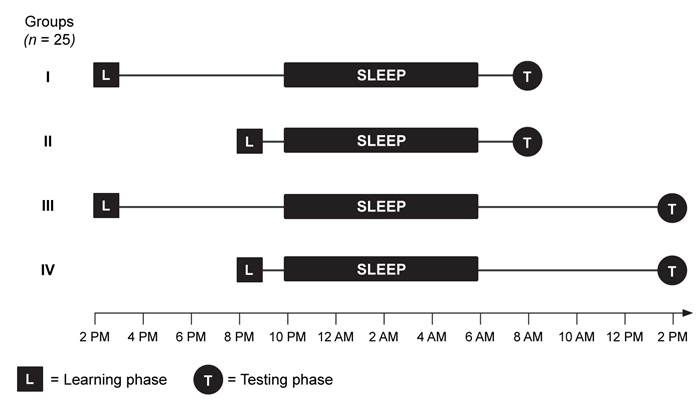Passage
Before memories have been consolidated they are considered "labile," or unstable and easily altered. Sleep is theorized to be essential to the process of memory consolidation, though the mechanisms for this are still under investigation. Rapid eye movement (REM) sleep has long been assumed to be the sleep stage most important for overall memory consolidation, but recent research suggests that different types of memory may be consolidated during different sleep stages. Procedural memories appear to be primarily consolidated during REM sleep while declarative memories appear to be primarily consolidated during slow-wave sleep (SWS) . Sleep duration, sleep regularity, and timing of sleep all contribute to the proportions of REM and SWS, so these factors also play an important role in memory consolidation processes.An experiment was performed at a large state university to investigate the relationship between sleep and learning in college students. Researchers screened potential participants with a sleep habits questionnaire. Those who reported having a regular sleep schedule were included in the study (N = 100) and given a vocabulary knowledge pretest. Participants were then randomly assigned to 1 of 4 experimental groups, each containing 25 students. During the learning phase (L) , each student was asked to memorize a set of 10 common toy objects (eg, car, ball, stuffed animal, blocks) and 10 vocabulary definitions that the student had labeled as "unknown" during the pretest. Images of the toy objects were presented in a sequence, one at a time, for 5 seconds each; the 10 vocabulary definitions were listed on a sheet that students were allowed to study for 10 minutes. During the testing phase (T) , students were asked to recall the objects in any order and define the vocabulary words (Figure 1) .
 Figure 1 Experimental design for each of the 4 groupsResults were reported as the average recall accuracy for the objects and vocabulary definitions, by group (Table 1) . Participants were then given a survey about the techniques they used when attempting to remember the toy objects and vocabulary definitions. Some students reported associating the definitions and objects with one another. For instance, one student reported that she related the words "plucky" (meaning brave) and "tocsin" (meaning an alarm) to an image of a toy fire truck, making it easier to recall the toy object and both associated vocabulary definitions.Table 1 Average Recall Accuracy, per Group
Figure 1 Experimental design for each of the 4 groupsResults were reported as the average recall accuracy for the objects and vocabulary definitions, by group (Table 1) . Participants were then given a survey about the techniques they used when attempting to remember the toy objects and vocabulary definitions. Some students reported associating the definitions and objects with one another. For instance, one student reported that she related the words "plucky" (meaning brave) and "tocsin" (meaning an alarm) to an image of a toy fire truck, making it easier to recall the toy object and both associated vocabulary definitions.Table 1 Average Recall Accuracy, per Group

-If the students who related the toy objects and definitions to each other had higher-than-average recall scores, to which of the following might this be attributed?I. Spreading activationII. Semantic networksIII. Source monitoring
A) I only
B) II only
C) III only
D) I and II only
Correct Answer:
Verified
Q36: Passage
Language is a skill acquired during early
Q37: Passage
Numerous studies suggest that physicians make both
Q38: Passage
Of the biological factors impacting color perception
Q39: Passage
Numerous studies suggest that physicians make both
Q40: Passage
Of the biological factors impacting color perception
Q42: Passage
Across the lifespan, mental and physical health
Q43: Passage
The highly addictive nature of cigarettes can
Q44: Passage
Before memories have been consolidated they are
Q45: Passage
Across the lifespan, mental and physical health
Q46: Passage
A common misconception in medicine is that
Unlock this Answer For Free Now!
View this answer and more for free by performing one of the following actions

Scan the QR code to install the App and get 2 free unlocks

Unlock quizzes for free by uploading documents